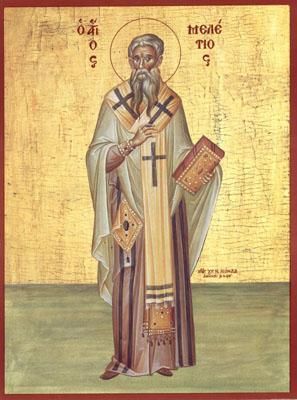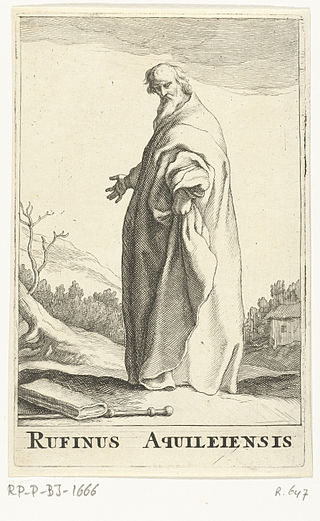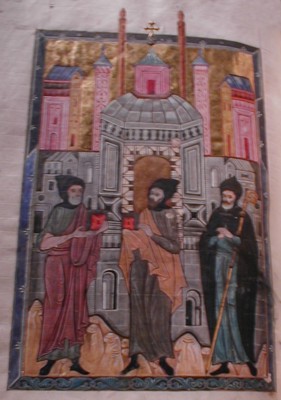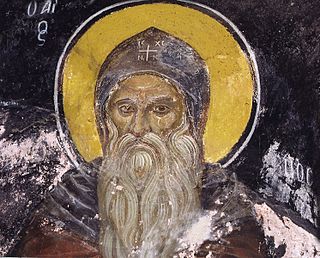
Paulinus of Nola born Pontius Meropius Anicius Paulinus, was a Roman poet, writer, and senator who attained the ranks of suffect consul and governor of Campania but – following the assassination of the emperor Gratian and under the influence of his Hispanic wife Therasia of Nola — abandoned his career, was baptized as a Christian, and probably after Therasia's death became bishop of Nola in Campania. While there, he wrote poems in honor of his predecessor Saint Felix and corresponded with other Christian leaders throughout the empire. He is credited with the introduction of bells to Christian worship and helped resolve the disputed election of Pope Boniface I.

Saint Meletius was a Christian bishop of Antioch from 360 until his death in 381. However, his episcopate was dominated by a schism, usually called the Meletian schism.

Tyrannius Rufinus, also called Rufinus of Aquileia, was a monk, philosopher, historian, and theologian who worked to translate Greek patristic material, especially the work of Origen, into Latin.

Cenobiticmonasticism is a monastic tradition that stresses community life. Often in the West the community belongs to a religious order, and the life of the cenobitic monk is regulated by a religious rule, a collection of precepts. The older style of monasticism, to live as a hermit, is called eremitic. A third form of monasticism, found primarily in Eastern Christianity, is the skete.

John Cassian, also known as John the Ascetic and John Cassian the Roman, was a Christian monk and theologian celebrated in both the Western and Eastern churches for his mystical writings. Cassian is noted for his role in bringing the ideas and practices of early Christian monasticism to the medieval West.

The Desert Fathers or Desert Monks were early Christian hermits and ascetics, who lived primarily in the Scetes desert of the Roman province of Egypt, beginning around the third century AD. The Apophthegmata Patrum is a collection of the wisdom of some of the early desert monks and nuns, in print as Sayings of the Desert Fathers. The first Desert Father was Paul of Thebes, and the most well known was Anthony the Great, who moved to the desert in AD 270–271 and became known as both the father and founder of desert monasticism. By the time Anthony had died in AD 356, thousands of monks and nuns had been drawn to living in the desert following Anthony's example, leading his biographer, Athanasius of Alexandria, to write that "the desert had become a city." The Desert Fathers had a major influence on the development of Christianity.

Paisius Velichkovsky or Wieliczkowski was an Eastern Orthodox monk and theologian who helped spread staretsdom or the concept of the spiritual elder to the Slavic world. He is a pivotal figure in Orthodox Church history.

Evagrius Ponticus, also called Evagrius the Solitary, was a Christian monk and ascetic from Heraclea, a city on the coast of Bithynia in Asia Minor. One of the most influential theologians in the late fourth-century church, he was well known as a thinker, polished speaker, and gifted writer. He left a promising ecclesiastical career in Constantinople and traveled to Jerusalem, where in 383 AD he became a monk at the monastery of Rufinus and Melania the Elder. He then went to Egypt and spent the remaining years of his life in Nitria and Kellia, marked by years of asceticism and writing. He was a disciple of several influential contemporary church leaders, including Basil of Caesarea, Gregory of Nazianzus, and Macarius of Egypt. He was a teacher of others, including John Cassian and Palladius of Galatia.

Melania the Younger is a Christian saint, Desert Mother, and ascetic who lived during the reign of Emperor Honorius, son of Theodosius I. She is the paternal granddaughter of Melania the Elder.

Euphrosyne of Alexandria, also called Euphrosynē, was a saint who disguised herself as a male to enter a monastery and live, for 38 years, as an ascetic. Her feast day is celebrated on September 25 by the Greek Orthodox Church and Byzantine Rite Catholics, on September 27 by the Episcopal Church, and on January 16 by the Roman Catholic Church. Euphrosyne was born to a wealthy family in Alexandria; her father Paphnutius was a devout Christian and her mother died when Euphrosyne was twelve. When she was 18, her father wanted her to marry, so she escaped, disguised as a man, and entered the same monastery he often visited for spiritual counsel. She spent most of her years as a monk in seclusion because her beauty tempted the other monks. During the final year of her life, Euphrosyne became her father's spiritual director, comforting his grief over losing his only daughter. Eventually, she revealed her identity to him and they reconciled. After she died, he entered her monastery and became an ascetic himself, living in her cell until he died ten years later.

Marcellina was born in Trier, Gaul the daughter of the Praetorian prefect of Gaul, and was the elder sister of Ambrose of Milan and Satyrus of Milan. Marcellina devoted her life as a consecrated virgin to the practice of prayer and asceticism. Her feast is on 17 July.

Paula of Rome (AD 347–404) was an ancient Roman Christian saint and early Desert Mother. A member of one of the richest senatorial families which claimed descent from Agamemnon, Paula was the daughter of Blesilla and Rogatus, from the great clan of the Furii Camilli. At the age of 16, Paula was married to the nobleman Toxotius, with whom she had four daughters, Blaesilla, Paulina, Eustochium, and Rufina. She also had a boy, also named Toxotius. Disciple of Saint Jerome, she is considered the first nun in the history of Christianity.

Pambo was a Coptic Desert Father of the fourth century and disciple of Anthony the Great. His feast day is July 18 among the Oriental Orthodox, Eastern Orthodox, and Catholic churches.

The Lausiac History is a seminal work archiving the Desert Fathers written in 419–420 AD by Palladius of Galatia, at the request of Lausus, chamberlain at the court of the Byzantine Emperor Theodosius II.
Monasticism is a way of life where a person lives outside of society, under religious vows.
Amma (Mother) Sarah of the Desert was one of the early Desert Mothers who is known to us today through the collected Sayings of the Desert Fathers and of the Holy Women Ascetics. She was a hermit and followed a life dedicated to strict asceticism for some sixty years.

Desert Mothers is a neologism, coined in feminist theology as an analogy to Desert Fathers, for the ammas or female Christian ascetics living in the desert of Egypt, Palestine, and Syria in the 4th and 5th centuries AD. They typically lived in the monastic communities that began forming during that time, though sometimes they lived as hermits. Monastic communities acted collectively with limited outside relations with lay people. Some ascetics chose to venture into isolated locations to restrict relations with others, deepen spiritual connection, and other ascetic purposes. Other women from that era who influenced the early ascetic or monastic tradition while living outside the desert are also described as Desert Mothers.
Therasia was a Christian aristocrat from Spain. Through her marriage to Paulinus of Nola, she encouraged his conversion to Christianity and was influential in the early church, co-writing epistles and co-patron of the cult of St Felix with her husband. She was St Augustine's first female correspondent and was praised by him for her holiness. Augustine gave Therasia and Paulinus the gift of a loaf of bread, potentially for use in the Eucharist.
Albina was a late Roman religious patron, correspondent of St Augustine and was the mother of Melania the Younger.
Ancient Christian Writers: the works of the Fathers in translation is a book series with English translations of works by early Christian writers. The translations are made from Latin and Greek. The series was founded by Johannes Quasten and Joseph C. Plumpe, the first volume being published in 1946.















